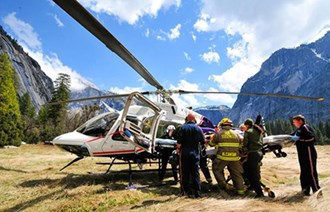
NPS Photo
National Park Service rangers and the United States Park Police (USPP) not only enforce the laws that protect people and the parks, but also can be called upon to respond to emergency medical incidents, structural and wildland fire calls, and search and rescue (SAR) missions, often times in cooperation with local, county, or state entities. Although search and rescue in the park is a function of the Ranger Division, they can also gain assistance from the park’s helitack crews, as well as other park personnel.

NPS Photo
Aviation’s Role in Search and Rescue (SAR)
The NPS provides SAR for persons within NPS areas and assists local agencies through mutual aid agreements. The NPS responds to approximately 4,500 SAR incidents annually, which consume a total of approximately 50,000-100,000 personnel hours. Incidents range from searching for lost hikers to performing complex technical rescues in high altitude, mountainous environments. In addition to helicopters in some cases, various types of technical equipment and vehicles are used to perform these jobs, including computer-based SAR programs, satellite technology, snow vehicles, and watercraft.
Aviation Elements in SAR
Aerial Reconnaissance—Although some parks have their own aviation equipment, others depend upon military, state, county, or other cooperators to provide aircraft that will assist in aerial searches for missing or injured visitors.
Deployment of Search Personnel—Aircraft can be used to bring rescuers closer to victims. The most common method would be to simply ferry searchers to the search site by airplane or helicopter.
Insertion—Some park personnel and the USPP are trained and certified to perform short-haul, rappel, power on landing, and/or hoist techniques, which can all be used to insert rescue personnel once a victim is located.
Another option for the pilot and rescuers is a Single-skid, Toe-in, and hover Exit/entry Procedure (STEP) if they have trained and been certified to do so. In a single-skid procedure, the pilot brings the helicopter into a point as close as possible to the victim and touches one skid or wheel down while still maintaining lift with the blades. The rescuer then exits the aircraft without it ever completely landing and administers aid or prepares the injured person for extraction.

Extraction/Transportation—If the victim is in an area that will present danger to the rescuers trying to use ground rescue methods, the helicopter and crew can perform short-haul, rappel, power on landing, and/or hoist for extraction. Victims can either be transported via aircraft to the nearest hospital or to a landing zone to be transported by ground.

NPS photo
Spotlight On—Yosemite SAR
Posted: August 1, 2015, Nevada Fall Rattlesnake Bite
On June 29, 2015, sometime around 4 pm, a 49-year-old day hiker at the top of Nevada Fall experienced what many people would consider their worst nightmare: being bitten, and envenomated, by a rattlesnake. He was an experienced hiker and had come across rattlesnakes in the wild before.
The top of Nevada Fall was the objective for the subject and his family. Upon reaching the footbridge at the top of the fall, they decided to do what many hikers feel the need to do after walking in the afternoon heat: take off their shoes and cool their feet at a safe spot in the river. As the subject made his way back onto the granite shoreline, he stepped down into a shallow recess between several rocks and was immediately bitten on the right foot. Moments later, another member of the subject’s family dialed 911 and reported the incident, at which time Yosemite Search and Rescue began to mobilize their response.
A rescue team began hiking to the patient's location as park helicopter 551 mobilized. Approximately one hour after being bitten, 551 airlifted the subject from the top of Nevada Fall and flown to the valley floor, where medical care was waiting. The clinic staff administered antivenom medication to the subject, stabilized him, and readied him for transport to a regional hospital via a medical helicopter.
During a follow-up interview with the patient two weeks after the incident, several details came to light that could prove to be beneficial to other hikers. First, the snake was well hidden under a rock and was not visible. And second, the rushing Merced River would have obscured any warning rattle.
Many people see rattlesnakes while hiking in Yosemite. Snake bites are rare (only one person has apparently died in Yosemite due to a snake bite), but it is important to know that they do occur and that the resulting injuries can be serious: this subject spent several days in the hospital recovering from his bite. Snakes are generally very shy and will avoid contact with humans. In this particular case, the snake was probably trying to hide and stay cool when the subject surprised it by stepping next to it. It is understandable that the patient was barefoot while wading, but for the rest of the hike, a pair of sturdy shoes can protect against many snakebites. An important lesson to learn from this incident is to always be aware of where you place your hands and feet—in addition to snakes, crevices can hide scorpions, spiders, and yellow jacket nests. In this case it wasn’t the obvious hazards of the quickly flowing river, the granite cliffs, or the midday heat that proved most dangerous.
If you are bitten by a snake, try to identify the snake (or have someone else do so), if it's safe to do so. Stay calm and avoid unnecessary physical exertion. The most effective treatment for snakebites is to seek medical care at a hospital or emergency room as quickly as possible. Gone are the days when snakebite first aid involved cutting into the bite and sucking the venom out of the body.
Finally, always treat wildlife with respect and give them the space they need to stay wild. Never approach wildlife to feed, pet, or photograph them. No matter how tame the animal appears, it is wild and could spook easily.
Last updated: April 11, 2023
